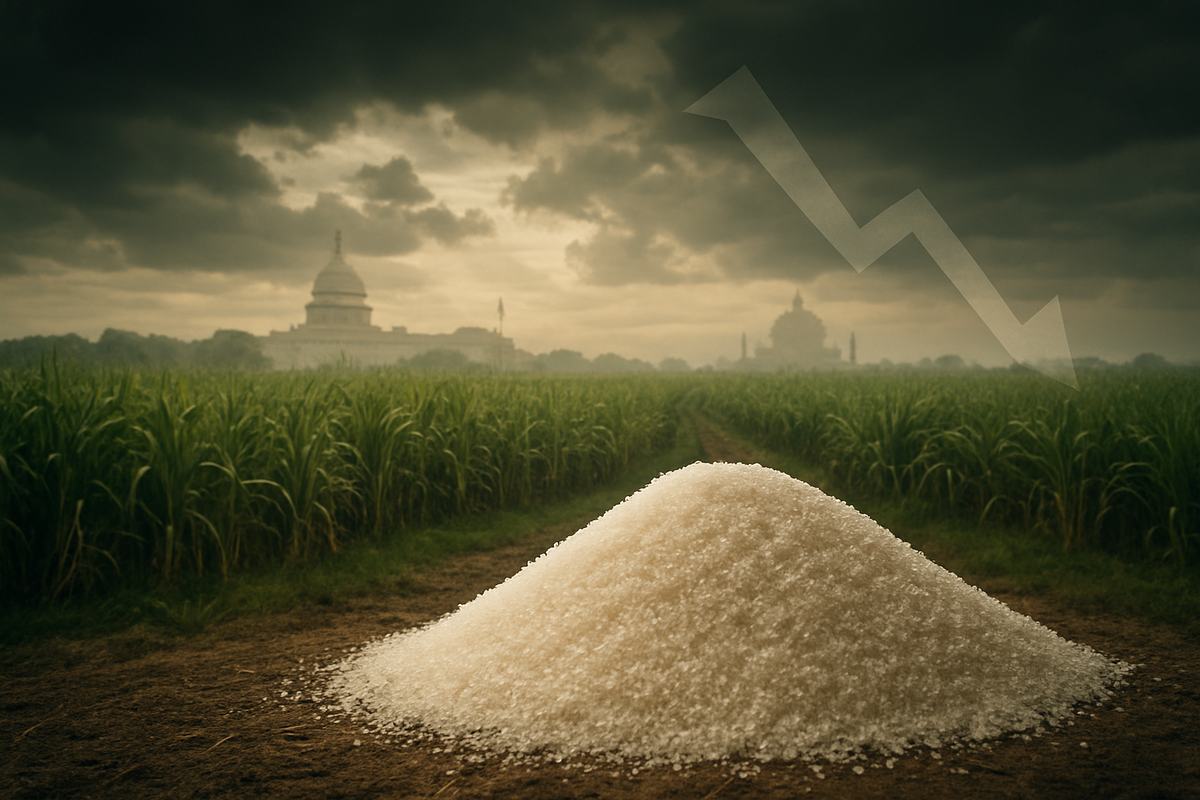Financial News
Sugar Futures: A Fleeting Bounce Amidst Mounting Global Surplus and Shifting Trade Winds

Raw sugar futures recently experienced a notable, albeit brief, rally from multi-year lows, driven by a confluence of optimism surrounding potential resolutions to US government shutdown talks and evolving export policies from India. This short-lived uplift provided a momentary sweet spot in an otherwise challenging market, as prices had been largely depressed by expectations of a burgeoning global surplus. The immediate implications of these intertwined political and supply-side factors are creating a complex and predominantly bearish outlook for raw sugar prices, with the initial bounce appearing more as a technical correction rather than a fundamental shift in market sentiment.
This article, written on November 10, 2025, delves into the nuances of this market movement, examining how US political developments and India's strategic trade maneuvers are influencing the global sugar landscape. While a brief period of short-covering and renewed risk appetite offered a glimpse of recovery, the underlying fundamentals point towards sustained downward pressure, forcing stakeholders across the value chain to re-evaluate their strategies in an increasingly oversupplied market.
The Brief Respite: Unpacking the Sugar Market's Volatility
The global sugar futures market has been a roller coaster of late, marked by a significant rebound from multi-year lows around early November 2025, quickly followed by a return to a broader downtrend. On November 10, 2025, raw sugar futures saw a rally, climbing 1.8% to 14.36 cents per pound, shaking off what had been a five-year low. White sugar futures also mirrored this uptick, rising 0.7% to $412.60 per ton on the same day. This fleeting recovery followed a prolonged period where prices hovered around December 2020 lows, largely influenced by forecasts of a global surplus fueled by robust harvests in major producing countries like Brazil, India, and Thailand. Just days prior to this bounce, raw sugar futures had dipped below the 15-17 cents/lb range, hitting a low of 14.3 cents/lb on November 6, 2025, with both London and New York futures posting significant multi-year lows.
The optimism surrounding a resolution to the ongoing US government shutdown played a crucial, albeit indirect, role in boosting overall market sentiment, including for commodities. After weeks of legislative deadlock, the US Senate took a procedural step forward on November 9, 2025, on a measure aimed at reopening the federal government after a 40-day shutdown. Hopes grew on November 10, 2025, that an end was in sight, as a group of moderate Senate Democrats backed a deal to reopen the government and fund some departments through January 30. While not directly tied to sugar fundamentals, this general improvement in risk appetite provided a temporary lift across commodity markets.
Simultaneously, India, the world's second-largest sugar producer, implemented significant changes in its export policy, contributing to the sugar market's initial bounce. After indications in September 2025 of a substantial return to the global market, and discussions in October about allowing exports due to surplus stocks, Indian Food Minister Pralhad Joshi formally announced on November 7, 2025, the government's decision to permit the export of 1.5 million metric tons (MT) of sugar for the 2025-26 sugar season. This move, aimed at supporting sugarcane farmers and managing surplus stocks, was coupled with the removal of a 50% export duty on molasses. However, a key debate emerged: analysts, including those from Green Pool, questioned whether these exports could fully materialize without official support, given that global sugar prices currently trail India's domestic rates. Despite this, the policy clarity from India provided a positive signal to the market. Key stakeholders include the Indian government, industry associations like the Indian Sugar & Bio-Energy Manufacturers Association (ISMA), major Indian sugar producers, global traders and analysts, and sugarcane farmers.
Corporate Fortunes: Who Wins and Who Loses in a Volatile Sugar Market?
The current dynamics in the sugar futures market, characterized by an initial bounce followed by a prevailing trend of declining prices due to global oversupply, present a mixed bag for public companies. While a sustained price increase would undoubtedly benefit sugar producers, the reality of a global surplus means many are bracing for continued headwinds. Most Indian sugar companies, however, have diversified business models, which helps mitigate the cyclical nature of the sugar industry.
Potential Winners (in a scenario of rising prices or through diversification):
Integrated sugar producers, particularly those in India with significant ethanol and power co-generation capacities, are best positioned to weather the storm or capitalize on any price recovery.
- Balrampur Chini Mills Ltd. (NSE: BALRAMCHIN): As one of India's largest integrated sugar manufacturers, its strong ethanol production and power co-generation (from bagasse) provide a crucial hedge against falling sugar prices. While lower sugar prices would impact its sugar segment, stable demand and pricing for ethanol, driven by government blending mandates, offer resilience.
- Triveni Engineering & Industries Ltd. (NSE: TRIVENI): Another diversified conglomerate with prominent positions in sugar, ethanol, and power transmission. Its substantial ethanol capacity (860 KLPD) and engineering segments offer strong protection, though sustained sugar price declines would still pressure its overall profitability.
- Dhampur Sugar Mills Ltd. (NSE: DHAMPURSUG): With operations in sugar, chemicals, ethanol, and co-generated power, its diversification into ethanol and value-added products helps mitigate risks from fluctuating sugar prices.
- EID Parry (India) Ltd. (NSE: EIDPARRY): Part of the Murugappa group, this company's robust diversification into nutraceuticals and farm inputs (through Coromandel International Limited) provides a substantial buffer against declining sugar prices. Its strategic shift towards bioenergy further enhances resilience.
- Dalmia Bharat Sugar and Industries Ltd. (NSE: DALMIASUG): A leading integrated sugar producer with significant cane crushing, co-generation, and distillery operations. Its export capabilities mean it could benefit from any global price increase, but it also faces pressure from falling international prices.
- Shree Renuka Sugars Ltd. (NSE: RENUKA): As a global agribusiness and bio-energy corporation with operations in India and Brazil, and significant ethanol and power co-generation, it would be a major beneficiary of higher global sugar prices. However, its global exposure also means it's directly impacted by the current oversupply and declining prices.
- Bajaj Hindusthan Sugar Ltd. (NSE: BAJAJHIND): One of India's largest sugar producers, with integrated operations including distilleries for ethanol and co-generation. Its fate largely aligns with its peers, relying on diversification to offset sugar price volatility.
Potential Losers (in a scenario of sustained falling prices):
Companies heavily reliant on sugar production without significant diversification, or those operating in high-cost regions, would face significant pressure.
- Less Diversified Producers: Any sugar producer globally that lacks substantial ethanol or power co-generation segments, or other diversified revenue streams, would see their margins severely squeezed by falling sugar prices.
- Food & Beverage Companies (initially): While lower raw material costs could eventually benefit them, a volatile market makes planning difficult. However, in a sustained low-price environment, these companies (e.g., confectionery, soft drinks) ultimately benefit from cheaper input costs, potentially improving their profit margins.
The current market outlook, as of November 2025, points towards declining sugar prices due to a global surplus. In this scenario, the diversified Indian integrated sugar companies, while facing headwinds in their sugar segments, would rely heavily on their ethanol and power revenues to maintain profitability. Companies with less diversification and heavier reliance on sugar sales would be more vulnerable.
Wider Significance: A Global Commodity in Flux
The sugar market's recent dynamics, characterized by a brief price bounce quickly overshadowed by a prevailing trend of declining prices due to a projected global surplus, hold wider significance for the broader commodities landscape, international trade, and agricultural policies. This situation, as of November 10, 2025, reflects a complex interplay of environmental, economic, and political factors.
The decline in sugar prices is part of a broader trend of falling global food commodity prices observed in late 2025. This trend is a significant factor in curbing global inflation, particularly benefiting emerging economies. However, it also highlights the persistent challenges of "supply chain stress" and unpredictable weather patterns that continue to define the commodities market. The inverse relationship between crude oil, corn, and sugar markets is particularly evident: lower oil and corn prices make ethanol less profitable, prompting mills in major producing countries like Brazil to prioritize sugar production, thereby increasing global supply.
The ripple effects are far-reaching. Sugar producers and farmers, especially those in high-cost regions, face declining revenues and squeezed profit margins. This financial strain could lead to difficulties for individual farmers and larger agricultural enterprises, potentially impacting rural economies. Conversely, food processors and manufacturers benefit from lower input costs, which could intensify competition within the food industry or allow them to pass on savings to consumers. However, other escalating costs like import tariffs and environmental compliance can temper these benefits.
Regulatory and policy implications are paramount, especially regarding India's export policies. India's decision to allow 1.5 MT of sugar exports for the 2025-26 season, after a period of restrictions, aims to manage domestic surplus and support local mills. However, this move has reignited concerns about WTO obligations. The WTO previously ruled in 2021 that India's sugar subsidies distorted global markets. The resumption of exports, described by some as "ignoring previous WTO rulings," has sparked concerns from countries like Australia about potential market disruptions and unfair trading conditions, suggesting future trade disputes are possible.
Historically, the sugar market has been prone to significant price swings. The current decline, driven by global surplus, echoes past periods of oversupply, such as the late 1990s when prices fell dramatically due to stock build-ups. Conversely, periods of high prices, like 2009-2011, were driven by adverse weather and ethanol demand. These historical precedents underscore the market's sensitivity to weather, energy prices (affecting ethanol diversion), and governmental trade policies. The current situation, while substantial, is considered "mild by historical standards" compared to previous sugar bull market pullbacks, which often saw drops of 40-60%. This context suggests that while the current downturn is significant, the market has seen greater volatility in the past, implying a potential for future, more dramatic shifts.
What Comes Next: Navigating a Sweetly Oversupplied Future
The global sugar market, as of November 10, 2025, is poised for continued oversupply and depressed prices in the short to medium term. The overwhelming consensus among analysts points to a substantial global sugar surplus for the 2025/26 season, with estimates ranging from 1.98 MMT to as high as 9.3 MMT. This is driven by anticipated record production from Brazil (44.7-45 MMT), bumper crops in India (31-35.3 MMT), and increased output from Thailand (10.3-10.5 MMT). Lower crude oil prices further exacerbate this by making ethanol less attractive, pushing Brazilian mills to prioritize sugar production.
Short-term possibilities (next 9-12 months): Sugar prices are expected to remain low, with the market fundamentally bearish. While minor rallies might occur, significant price appreciation is unlikely without major supply shocks. Trading Economics forecasts sugar at 13.96 cents/lb by the end of Q4 2025 and 12.99 cents/lb in 12 months. Potential La Niña conditions in late 2025 and early 2026 could introduce weather variability, potentially tightening supply in specific regions and sparking a rally, but this remains a speculative factor.
Long-term possibilities (beyond 12 months): Prices are projected to stay low before strengthening moderately in subsequent years, though likely remaining lower in real terms than a decade ago. The persistent global surplus will continue to challenge sustained price appreciation.
Strategic pivots and adaptations are critical for producers and stakeholders. Diversification into ethanol production remains a crucial strategy, particularly in India and Brazil, driven by government blending mandates. Mills must invest in efficient processing to maximize ethanol yield, though profitability remains sensitive to crude oil prices. Focus on sustainability and efficiency is paramount, as cost reduction becomes vital in a low-price environment. Modernization, technology adoption, and the development of specialty sugars also offer avenues for resilience. Proactive risk management and advocacy for stable policy frameworks, particularly in India regarding export quotas and ethanol pricing, are essential for creating a predictable market environment.
Market opportunities exist in niche markets for specialty sugars, technological advancements in crop science, and the continued push for ethanol blending programs. However, significant challenges loom: the persistent global surplus, climate change and weather variability, fluctuating crude oil prices, and competition from alternative sweeteners. A new and emerging challenge is the growing popularity of GLP-1 drugs (like Ozempic), which could lead to a gradual decline in sugar consumption in wealthier nations, with broader impacts expected post-2026 as biosimilars become available.
Potential scenarios include a prolonged period of low prices, leading to consolidation in the industry; increased diversification into bioenergy; enhanced volatility driven by weather and geopolitics; and accelerated innovation in production and consumption patterns. The industry will also likely face ongoing trade protectionism and disputes over subsidies.
Comprehensive Wrap-up: Navigating the Sweet and Sour of Global Sugar
The global sugar market, as of November 10, 2025, finds itself in a precarious position. A fleeting bounce in futures prices, spurred by hopes of a US shutdown resolution and India's renewed export intentions, provided a brief moment of optimism. However, this appears to be a temporary reprieve within a fundamentally bearish landscape. The overwhelming reality is a significant global surplus for the 2025/26 marketing year, driven by bumper crops in Brazil, India, and Thailand, and a reduced diversion of sugarcane towards ethanol production due to lower oil prices. This oversupply has pushed raw sugar prices to multi-year lows, a trend expected to persist in the coming months.
Moving forward, the market will remain under intense downward pressure. While India's decision to allow 1.5 MMT of sugar exports for the 2025-26 season offers a potential outlet for its surplus, the disparity between global and domestic prices may hinder the full realization of these exports without further support. Brazilian ethanol policy, global demand trends (including the potential impact of GLP-1 drugs), and unpredictable weather patterns will be critical determinants of future price movements. The enduring significance of these dynamics lies in their profound impact on agricultural economies, international trade relations (especially concerning WTO compliance), and the profitability of sugar producers worldwide.
For investors, the coming months demand a cautious and strategic approach. The fundamental outlook remains bearish, suggesting a re-evaluation of long positions and potential opportunities in bearish strategies. Key factors to watch include any shifts in government policies in India regarding sugar export quotas and ethanol diversion, as these could introduce significant volatility. Tracking weather patterns in major producing regions, observing crude oil prices (which influence the sugar-ethanol mix), and monitoring global demand indicators, including the long-term effects of health trends, are crucial. Currency movements, particularly the strength of the US dollar, will also continue to play an important role.
In conclusion, the sugar market is entering a period defined by oversupply and price compression. While diversification into ethanol and a focus on efficiency offer some resilience for integrated producers, the broader market will continue to be a challenging environment. Investors must stay vigilant, adapting their strategies to navigate the complex interplay of supply, demand, and geopolitical factors that will shape the sweet, yet currently sour, future of global sugar.
This content is intended for informational purposes only and is not financial advice
More News
View More




Recent Quotes
View More
Quotes delayed at least 20 minutes.
By accessing this page, you agree to the Privacy Policy and Terms Of Service.



